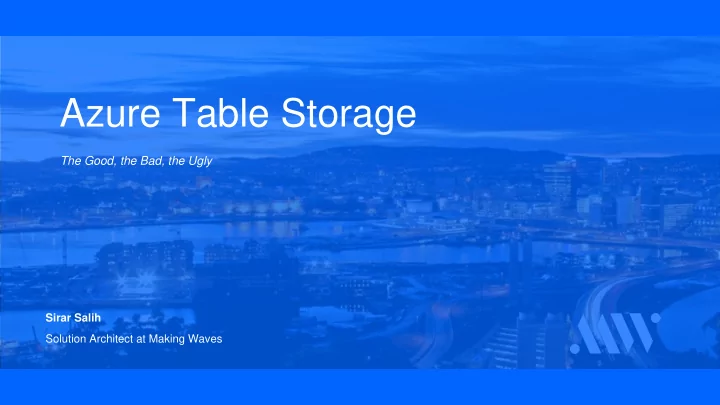

Azure Table Storage The Good, the Bad, the Ugly Sirar Salih Solution Architect at Making Waves
Manage Who Am I? Stakeholders Balancing stakeholder influence and customer needs Hydro is a global enterprise, with many different business stakeholders and content owners who have Sirar Salih different needs and priorities. Finding a good balance between corporate consistency Solution Architect at Making Waves and local business relevance while not falling into the trap of designing according to internal organisation rather than the customer can be challenging. Credit:
2018
Each NoSQL database has its good and bad side.
Azure Table Storage
Pros • Easy setup • Cheap • Minimal work required • Easy to understand • Simple model: Entity, PartitionKey, RowKey
Cons • Low on scalability • Lack of basic database operations - No «like» or «contains» • No backup procedure
Setup & usage
https://portal.azure.com Storage accounts Add
https://portal.azure.com Storage accounts Select storage account Access keys Connection string
Azure SDK
Azure Storage Explorer
Azure Storage Explorer
Connect and create table private const string tableName = "Customers"; private static CloudTable _cloudTable; public TableStorageService (KeyVaultSecretProvider keyVaultSecretProvider, string storageAccountName, string storageAccountKeyName) { var storageAccountKey = keyVaultSecretProvider. GetSecret (storageAccountKeyName); var connectionString = $"DefaultEndpointsProtocol=https;AccountName={storageAccountName};AccountKey={storageAccountKey};EndpointSuffix=core.windows.net"; var cloudStorageAccount = CloudStorageAccount. Parse (connectionString); var cloudTableClient = cloudStorageAccount. CreateCloudTableClient (); _cloudTable = cloudTableClient. GetTableReference (tableName); }
Entity public class CustomerEntity : TableEntity { public CustomerEntity () { } public CustomerEntity ( string lastName, string firstName) { PartitionKey = lastName; RowKey = firstName; } }
Insert entity var insertOperation = TableOperation. Insert ( new CustomerEntity ("Snow", "Jon")); await _cloudTable. ExecuteAsync (insertOperation);
Batch insert entities var tableBatchOperation = new TableBatchOperation (); for ( var i = 0; i < 100; i++) { tableBatchOperation. Insert ( new CustomerEntity ("Snow", $"Jon {i}")); if (i == 99) { await _cloudTable. ExecuteBatchAsync (tableBatchOperation); } }
Get entity var query = new TableQuery<CustomerEntity>() . Where (TableQuery. GenerateFilterCondition ("RowKey", QueryComparisons.Equal, "Jon")); _cloudTable. ExecuteQuery (query);
Delete entity var retrieveOperation = TableOperation.Retrieve<CustomerEntity>("Snow", "Jon"); var retrievedResult = await _cloudTable. ExecuteAsync (retrieveOperation); var deleteEntity = (CustomerEntity)retrievedResult.Result; var deleteOperation = TableOperation. Delete (deleteEntity); await _cloudTable. ExecuteAsync (deleteOperation);
Blob containers • Blob container: Similar to a folder, containing a collection of blobs • Blob: A file of any format
Connect and create blob container private const string CustomersContainerName = "customers"; private static CloudBlobContainer _cloudBlobContainer; public Job ( string connectionString) { var cloudStorageAccount = CloudStorageAccount. Parse (connectionString); var cloudBlobClient = cloudStorageAccount. CreateCloudBlobClient (); _cloudBlobContainer = cloudBlobClient. GetContainerReference (CustomersContainerName); if (!_cloudBlobContainer. Exists ()) _cloudBlobContainer. Create (); }
Upload blob var cloudBlockBlob = _cloudBlobContainer. GetBlockBlobReference (blobName); cloudBlockBlob.Properties.ContentType = "application/json"; using ( var ms = new MemoryStream ()) { var j = JsonConvert. SerializeObject (json); var writer = new StreamWriter (ms); writer. Write (j); writer. Flush (); ms.Position = 0; cloudBlockBlob. UploadFromStream (ms); }
Download blob var cloudBlockBlob = _cloudBlobContainer. GetBlockBlobReference (blobName); await cloudBlockBlob. DownloadToFileAsync ("C:\Documents\customer.json", FileMode.Create);
Delete blob var cloudBlockBlob = _cloudBlobContainer. GetBlockBlobReference (blobName); await cloudBlockBlob. DeleteIfExistsAsync ();
Queues • Provide asynchronous cloud messaging between application components • A service for storing messages that can be accessed from anywhere • Single queue message up to 64 KB in size • Queue can contain millions of messages
Connect and create queue private const string queueName = "queue"; private static CloudQueue _cloudQueue; public Job ( string connectionString) { var cloudStorageAccount = CloudStorageAccount. Parse (connectionString); var cloudQueueClient = cloudStorageAccount. CreateCloudQueueClient (); _cloudQueue = cloudQueueClient. GetQueueReference (queueName); _cloudQueue. CreateIfNotExists (); }
Insert message var cloudQueueMessage = new CloudQueueMessage ("Hello, Jon Snow!"); await _cloudQueue. AddMessageAsync (cloudQueueMessage);
Peek at message var cloudQueueMessage = await _cloudQueue. PeekMessageAsync (); Console. WriteLine (cloudQueueMessage.AsString);
Update message content var cloudQueueMessage = await _cloudQueue. GetMessageAsync (); cloudQueueMessage. SetMessageContent ("New content."); _cloudQueue. UpdateMessage (cloudQueueMessage, TimeSpan. FromSeconds (60.0), MessageUpdateFields.Content | MessageUpdateFields.Visibility);
Delete message var cloudQueueMessage = await _cloudQueue. GetMessageAsync (); await _cloudQueue. DeleteMessageAsync (cloudQueueMessage);
Get number of messages _cloudQueue. FetchAttributes (); var messageCount = _cloudQueue.ApproximateMessageCount;
File shares • Easy-to-use cloud file system • Upload, download files • Can be mounted in Windows, Linux, and macOS • Snapshots
https://portal.azure.com Storage accounts Select storage account Overview Files
Performance
Troy Hunt Credit: https://www.troyhunt.com, Troy Hunt.
Troy Hunt Credit: https://www.troyhunt.com, Troy Hunt.
Troy Hunt • 9 simultaneous importers • Total average speed at 22 500 inserts pr. second Credit: https://www.troyhunt.com, Troy Hunt. Credit: https://www.troyhunt.com, Troy Hunt.
Troy Hunt http://haveibeenpwned.com/HowFastIsAzureTableStorage/?email=troyhunt@hotmail.com Credit: https://www.troyhunt.com, Troy Hunt. • A query of 154 million records returns result in 4 milliseconds
vs
vs • Some similarities • Table storage lacks backup procedure, while CosmosDB has it • Table storage has storage-based pricing, while CosmosDB has throughput-based • Table storage is aimed at high capacity on a single region, while CosmosDB aims at global distribution, high throughput • Choosing which depends on different scenarios
Mobile apps • A good choice for mobile apps • But Azure Easy Tables is better - An app service - Backed by Azure SQL and geared towards mobile apps
https://github.com/Azure/azure-storage-ios
https://github.com/Azure/azure-storage-android
The way forward • Azure Table storage lives on (we hope!) • A need to get further support and new functionality • Lack of basic database operations is a problem • Ease of setup and use is a definite plus, that’s where Table storage shines
Thanks! Credit:
Recommend
More recommend